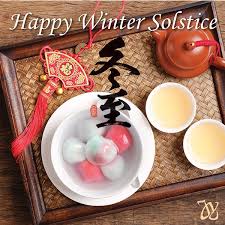The Winter or December Solstice takes place here today, 22 Dec 2014, and is known as the longest night of the year, but that really depends on which part of the world you're in.
The longest night for the northern hemisphere is also the longest day - and peak of summer - for the southern hemisphere.
Here are some things to know about the Winter Solstice:
- From space: It's all about the tilt
- Back on Earth: Less sun, longer nights
- But Singapore is on the Equator, so is there really a lot of difference?
- Doesn't really matter, we still celebrate it
- This year's Winter Solstice is not the longest night ever
read more
6 traditional foods for Dongzhi
Tangyuan
Dongzhi or the Winter Solstice is celebrated by the Chinese as a day for family gatherings.
Traditionally, glutinous rice balls or tangyuan are served. However it is not all about the tangyuan.
People's Daily Online put together the six traditional foods for Dongzhi, which falls on Dec 22 this year.
read more
Malaysian Chinese Kitchen posted a video to the playlist Malaysian Chinese Kitchen Cooking Show. 18 hrs
Kuih Ee is a dessert of glutinous rice balls in syrup eaten as a symbol of unity and togetherness during Tang Chek, weddings, birthdays, and the Chinese New Year.
How To Make Glutinous Rice Dumplings (Tang Yuan)
When it’s time to celebrate the winter solstice during the Dongzhi Festival, it’s most traditional to eat the glutinous rice dumplings known as tang yuan. These small, round dumplings symbolize family unity, an important theme during a time of year when the seasons begin to tilt toward the warmth of spring.
Though tang yuan are served with myriad fillings, the dumplings eaten during the Dongzhi Festival are typically plain. The dumplings are normally dyed bright colors and are served in a bowl of sweet ginger-infused syrup. While you can buy tang yuan at the store, they’re a snap to make at home. The dumpling dough takes just a few minutes to prepare and rolling the tang yuan balls is a fun family activity that young chefs will love. Set up around the kitchen table and put some music on in the background.
While glutinous rice dumplings are silky smooth and pleasantly chewy, they’re relatively tasteless themselves and act as a vessel for the flavor of their filling or the broth they’re served in. If you live in a colder region of the United States, I’m sure you’ll enjoy eating a bowl of tang yuan in a warming ginger syrup during the heart of winter.
WINTER SOLSTICE 2020: THE FIRST DAY OF WINTER
The winter solstice marks the official beginning of astronomical winter (as opposed to meteorological winter, which starts about three weeks prior to the solstice). The winter solstice occurs once a year in each hemisphere: once in the Northern Hemisphere (in December) and once in the Southern Hemisphere (in June). It marks the start of each hemisphere’s winter season. When one hemisphere is experiencing their winter solstice, the other is simultaneously experiencing their summer solstice! This is all thanks to Earth’s tilted axis, which makes it so that one half of Earth is pointed away from the Sun and the other half is pointed towards it at the time of the solstice.
The winter solstice holds significance across a variety of cultures, as it signals the changing of the seasons. Some ancient peoples even marked the solstice using huge stone structures, like Newgrange in Ireland. In some cultures, the solstice traditionally marked the midway point of the season rather than the start of it, which explains why holidays such as Midsummer Day are celebrated around the first day of summer.
On the day of the winter solstice, we are tilted as far away from the Sun as possible, which means that the Sun’s path across the sky is as low in the sky as it can be. Think about the daily path of the Sun: It rises in the east and sets in the west, arcing across the sky overhead. During the summer, the Sun arcs high in the sky, but during the winter, it arcs lower, closer to the horizon. How can we observe the effects of solstice ourselves? On the day of the solstice, stand outside at noon and look at your shadow. It’s the longest shadow that you’ll cast all year! Do this again on the day of the summer solstice and you’ll see almost no shadow.





